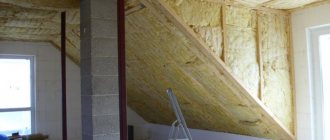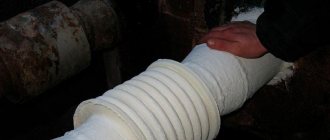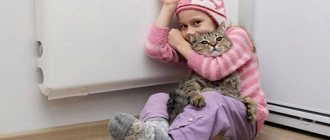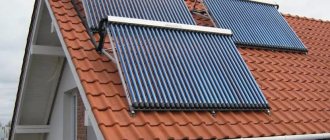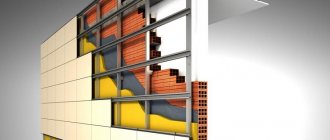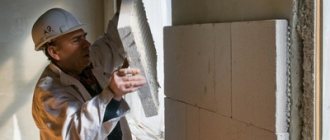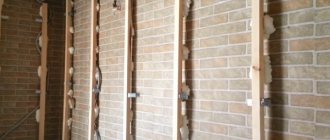External thermal insulation gives a much better effect than insulating a house from the inside. In addition to its main functions, insulation protects walls from precipitation, mechanical damage, and weathering, thereby extending the service life of the entire building. Installing insulation does not require special knowledge or skills, and most homeowners can easily cope with this task on their own. But in order to do everything as efficiently as possible, you need to know what materials are available for insulating walls outside, and how to attach them correctly.
Materials for external wall insulation
Insulation of walls outside
Difficulties and disadvantages of insulating walls inside the house
To understand why internal insulation often meets resistance not only from home owners, but also from professional builders, you need to consider all the negative aspects of this type of insulation. You can put up with some negative aspects, but there are also factors whose consequences can be quite serious.
The main disadvantages of internal insulation include:
- Reducing the usable area of the room. For example, if in a room measuring 3x6 meters you use 5 cm thick material to insulate the two outer walls, the area will become smaller by approximately 0.5 m².
- The complexity and high cost of the technology used. If the work is carried out in accordance with the regulations, then you will have to completely empty the room of furniture and carry out complex measures to arrange additional ventilation and protect the walls from condensation.
- Formation of “cold bridges”. Partitions, joints and internal structures in the walls, when cooling, cause cold penetration into the room and the appearance of condensation under the insulation.
- Health hazard. Some types of wall insulation can emit harmful volatile substances from the inside. You need to choose an environmentally friendly material that fully complies with safety requirements.
The main threat is posed by thermophysical processes occurring on surfaces insulated from the inside. It is because of them that streaks appear on the walls, and fungus and mold with a characteristic odor spread in the apartment. Such consequences result from improper installation of insulation, which disrupts the moisture exchange regime.
What does cotton wool mean? Why do problems arise when insulating from the inside?
The main disadvantages of internal wall insulation usually appear in winter. During this period, the difference between the air temperature inside and outside the room can be greatest. But problems often arise in the fall and spring, when the outside temperature is low.
The main enemy of all building structures is moisture. If water gets inside the insulation, it gets wet and becomes a favorable breeding ground for fungi and mold.
There is a direct relationship between ambient temperature and moisture on the walls. In conditions of temperature changes, vapors fall out of the air. When enough of them accumulate, condensation appears on the walls. In construction there is the concept of “dew point”. This is a certain temperature at which water appears on a cold surface.
This indicator depends on the state of the air in the room and the temperature inside the insulated layer. The more moisture in the air, the higher the dew point. That is, with increasing humidity, this indicator tends to a higher temperature. Even with a slight decrease, moisture will appear. Complex calculations are used to obtain dew point readings. When designing buildings, a summary table is used, which displays the temperature values of the dew point depending on the humidity and temperature inside the house.
According to SanPiN, the normal room temperature is considered to be +20-22°C, and the humidity standard is set at 55%. At such humidity and temperature values, the dew point will appear in the place on the wall where the temperature is +10.7°C.
The dew point can move within the wall structure. It is located closer or further from the interior. After all, in winter, houses are heated, but outside there are sub-zero temperatures. When the building envelope is multi-layered, the location of condensation is determined by the thickness and thermal conductivity of each layer. And a lot here depends on their relative position.
If the wall is not insulated, the dew point is located inside it. The enclosing structure transfers heat to the outside, so the room is cool even when the heating is turned on at full power.
If the insulation is installed outside, then the entire outer wall is well heated by the heating inside the room. The dew point then passes into the insulating layer, where condensation accumulates. Moisture must be removed periodically; for this purpose, ventilated facade technology is used.
Removal of moisture from an insulated ventilated facade.
When insulation is installed for walls inside an apartment, the outer walls freeze completely because access to heat is blocked by an insulating layer. The dew point moves indoors, closer to the insulation. But as the temperature outside rises, it can again go deeper into the wall.
With such fluctuations, condensation accumulates between the building envelope and the insulation, which significantly reduces the thermal insulation characteristics of the material. When the temperature drops, the moisture freezes, and then the adhesive layer may be destroyed. The walls get wet, and fungus and mold may subsequently appear.
Dew point for internal insulation
1. Area of condensation formation; 2. Insulation; 3. Wall; 4. Dew point.
The main positive aspects of thermal insulation inside a building include much more comfortable installation conditions than for external work. Laying is carried out in a warm room, there is no need to erect scaffolding. In addition, all activities can be carried out independently.
Why external insulation and not internal
The most understandable argument for a non-specialist sounds very convincing, although this is a secondary factor - insulation from the inside “takes away” the useful volume of residential and office premises.
Builders are guided by the standard according to which insulation must be external (SP 23-101-2004). Insulation from the inside is not directly prohibited, but it can only be carried out in exceptional cases. For example, when work on the outside cannot be carried out due to the design features or the facade “belongs” to a house that is classified as an architectural monument.
How to deal with the shortcomings of internal insulation
The Building Regulations do not recommend using insulation from the inside when designing the thermal insulation of premises. However, if internal insulation is necessary, the thermal insulation layer must be continuous and durable.
To prevent the occurrence of dampness, the place where the dew point is located should be isolated as much as possible from the effects of vapors.
For this purpose, a set of measures is provided:
1. Use of insulation with minimal vapor permeability. It is necessary that this characteristic of the material be less than that of the wall. The main rule is that the vapor permeability of layers in a multilayer structure should increase from the inside out. In this case, the moisture will gradually come out.
A - vapor barrier decreases from inside to outside; B - vapor barrier increases from inside to outside.
2. High-quality installation. It is recommended to lay the insulation with glue, and the adhesive is applied not pointwise, but over all surfaces (under the comb) in order to avoid leaving gaps.
Applying glue to the insulation under the comb.
3. Equipping the room with additional ventilation. High-quality air exchange will help avoid humidity. It is necessary to use mechanical ventilation systems or install control valves on windows.
Window ventilated valve.
4. Particular attention should be paid to cold bridges. When installing thermal insulation indoors, there is no opportunity to insulate the joints of external walls. Therefore, the insulator is laid over the adjacent walls. These projections can then be decorated with boxes.
5. Cover with a vapor barrier. If stone wool is used as insulation, then from the side of the room it must be hermetically sealed with a special vapor barrier membrane, and all joints are carefully sealed.
Installation of a vapor barrier membrane on top of the insulation.
Video description
The result of proper internal insulation of a house in the video:
Even such protection from the inside will not provide a 100% guarantee against the wall getting wet - water vapor will find its way into the film joints and fastening points Source domvpavlino.ru
That is, when deciding how to properly insulate a house, in the vast majority of cases, the answer will be based on clear regulatory recommendations - from the outside.
What type of insulation is best to use for walls inside the house?
Manufacturers of building materials today offer a wide selection of thermal insulators. However, not all materials are suitable for insulation from the inside. Each material has distinctive features that must be taken into account when choosing an insulator.
Expanded polystyrene
One of the best materials for insulating walls inside a house, providing effective thermal insulation, is polystyrene foam. There are foamed and extruded polystyrene foam.
Foamed polystyrene foam.
Extruded polystyrene foam.
For internal insulation, you can use both materials, but it is better to give preference to extruded polystyrene foam. It has greater density and is produced only by large manufacturers, whose quality control ensures the production of environmentally friendly material.
Expanded polystyrene retains heat well and does not allow moisture to pass through, which is why its popularity in internal insulation is constantly growing.
Compared to other insulators, polystyrene foam stands out:
- minimal water absorption;
- ease of installation;
- light weight;
- the ability to easily cut into desired shapes;
- resistance to loads.
Expanded polystyrene is available in the form of slabs of various thicknesses. For insulation inside the building, you can use thin slabs to save space as much as possible. The material does not absorb water and reliably isolates the dew point area. But for this it is necessary to carefully process the joints of the slabs and the junctions with the wall.
The use of slabs with stepped edges eliminates the appearance of cracks and gaps. Installation is carried out using an adhesive composition with additional fasteners using disc-shaped dowels. The glue must be applied to the slabs continuously, using a comb, so that there are no gaps between the wall and the insulation.
Installation of polystyrene foam on internal walls.
The outside of polystyrene foam must be finished with a layer of plaster using reinforcing mesh. The plaster layer is puttied, after which it is ready for installation of finishing materials.
The disadvantage of such a wall is the inability to hang heavy objects and insufficient sound insulation, since polystyrene foam does not have very good sound insulation properties.
Stone wool
Stone wool has high vapor permeability and is not very suitable for insulating walls inside a house. The problem is that it can absorb moisture from the room. When using this insulation, the main rule is violated - the vapor permeability of layers in a multilayer structure should increase from the inside out.
Even the use of a vapor barrier membrane is not always able to solve the problem. In the absence of artificial ventilation, this will certainly lead to moisture condensation on the vapor barrier layer. Which, in turn, will contribute to the formation of mold and fungi on the inner finishing layer.
If you need to insulate internal walls using stone wool, insulation manufacturers advise installing a load-bearing frame. Insulation boards must be laid between the frame supports, and a vapor barrier membrane must be installed on top of the frame and insulation.
Installation of stone wool.
Next, an additional one is packed on top of the first frame to create an air gap between the vapor barrier and the drywall. This will prevent the finishing material from getting wet.
Some builders use rolled wool, which is completely unsuitable for vertical walls. Such installation is cheaper and is carried out quickly, but the design becomes ineffective, since the rolled material is subject to shrinkage.
Stone wool has some undoubted advantages:
- fire safety;
- effective heat and sound insulation;
- environmental friendliness;
- durability.
We have discussed some brands of stone wool, the manufacturers of which allow the use of these insulation materials indoors, below.
Polyurethane foam
Polyurethane foam is well suited for internal thermal insulation. The cellular structure gives the material good thermal conductivity characteristics. The polyurethane foam cells are filled with air, all cells are hermetically sealed. The product reliably resists moisture without allowing it to pass through or absorb it.
A special feature of the innovative material is the method of application to the walls. It is sprayed as a two-component foam that hardens in a few seconds.
Application of polyurethane foam indoors.
The material differs from other insulation materials in its characteristics:
- high adhesion to any surface;
- tight connection with the wall;
- solidity of the coating;
- simplicity and speed of application;
- possibility of applying plaster.
Bringing into working condition - foaming - occurs at the processing site. The starting material has a small volume. Therefore, you will not need to spend money on its delivery and storage.
But there are exceptions! Insulation from plant materials.
Environmentally friendly insulation made from flax and hemp fibers have unique properties and, using them, you can deviate from generally accepted rules. Thermal insulation made from plant materials does not require the use of vapor barrier. Such thermal insulation can be used both internally and externally in almost any structure. If additional wall insulation is performed, then vapor barrier is not used at all. This is especially important when insulating wooden walls. This method of insulation allows you to maintain a favorable microclimate for a person in a wooden house, while significantly improving the heat-saving characteristics of the structure. If a frame house or roof is insulated with flax insulation or hemp insulation, then instead of a vapor barrier, special vapor barrier cardboard is used. Flax and hemp are natural antiseptics, they are not afraid of moisture and can remove moisture from the structure through their capillary fibers; this is their main difference from other non-organic insulation materials. Linen and hemp insulation are absolutely safe for humans, are not afraid of rodents, are durable and will last more than 70 years.
The best brands of insulation for walls inside the house
When choosing insulation for walls inside a house, it is better to focus on Russian manufacturers. When developing materials, domestic engineers take into account the specific climate of our country. Modern technological lines used in the production of insulation materials make it possible to achieve high quality products.
Styrofoam brands
TechnoNIKOL Logicpir L Wall
The insulation has a rigid cellular structure. Available in the form of slabs with an L-shaped edge around the perimeter. The connection of such material is made in a quarter, so no gaps are formed during installation. Foil insulation is applied on one side.
The product is used exclusively as insulation for walls inside the apartment. The small thickness of the sheets allows you to save room space. The characteristics of the material remain unchanged throughout the entire service life (25 years).
In many respects, the insulation is superior to analogues by almost two-thirds. The product has the lowest thermal conductivity - (0.022 W/(m*K). The plates reliably protect against the penetration of cold and do not release heat outside. The material does not absorb moisture from the air, and condensation does not form on the walls.
| Characteristics | Indicators |
| Coefficient of thermal conductivity | 0.022 W/(m*K) |
| Vapor permeability coefficient | 0.005 mg/m*h*Pa |
| Flammability group | G4 |
| Water absorption | no more than 1% by volume |
| Density | 30-35 kg/m³ |
Penoplex Wall
Extruded polystyrene boards are designed for effective thermal insulation of walls. The use of the latest generation material allows you to significantly save on heating a house or apartment. The main advantages of Penoplex Wall insulation are water-repellent properties, increased strength and environmental safety.
The material is used to create an insulating and soundproof layer on external and internal walls. A distinctive feature of Penoplex slabs is their milled surface, which is very convenient when applying plaster and adhesive compositions. Product quality control is carried out in accredited laboratories.
| Characteristics | Indicators |
| Coefficient of thermal conductivity | 0.032 W/(m*K) |
| Vapor permeability coefficient | 0.005 mg/m*h*Pa |
| Flammability group | G4 |
| Water absorption | no more than 0.5% by volume |
| Density | from 20 kg/m³ |
Ursa XPS-N-III-L G4
Ursa insulation is made of extruded polystyrene foam without the addition of freons. These are rigid slabs in shape, light in weight and high in density. Thanks to the special type of edges (L-shaped), the slabs are joined in a quarter without the formation of cracks or gaps.
The products are very durable and do not break during transportation. The insulation is used for installation both outside and indoors. The slabs can be laid on surfaces with increased load, for example, a hard floor. Improved strength allows the material to be used for installation on floors in industrial premises.
Ursa insulation does not absorb moisture, mold and mildew do not form on it. The plates reliably protect from cold during the entire period of operation (25 years).
| Characteristics | Indicators |
| Coefficient of thermal conductivity | 0.032 W/(m*K) |
| Vapor permeability coefficient | 0.004 mg/m*h*Pa |
| Flammability group | G4 |
| Water absorption | no more than 0.3% by volume |
| Density | 35 kg/m³ |
Thermal insulation materials - new products on the market
Additionally, you can always consider new options - they are a little more expensive, but often somewhat more effective than traditional ones.
Foamed polyurethane
A common polymer material for “household use”. Also well known as foam rubber for furniture (in the form of “soft” mats) or as polyurethane foam for sealing cracks. When insulating, it is also used in the form of slabs or sprayed insulation.
Polyurethane foam slabs have low tear-off holding properties, so they are not used in “wet façade” systems.
But this is a common thermal insulation material for making sandwich panels. The same technology underlies the production of thermal panels for facade cladding. Such a panel is a heat-insulating board with a decorative layer (clinker tiles or stone chips) already applied at the factory. Two types of insulation: polystyrene foam and polyurethane foam. In the first case, the thermal panel is two-layer, in the second – three-layer (OSB or moisture-resistant plywood is used as the supporting base). Two mounting options: on dowels/anchors (open method) or on your own hidden fastening system.
Three-layer thermal panel Source zafasad.ru
Sprayed polyurethane foam is in demand if it is necessary to create a seamless layer of thermal insulation on complex surfaces. Until recently, there was only one technology for applying such a layer - using professional installations working with a two-component composition (mixing occurs during spraying).
Spraying polyurethane foam onto the base of a house Source nauka-i-religia.ru
Now in Russia, for household use, the production of one-component polyurethane foam has been launched, which is produced in an aerosol can with a capacity of 1 liter. As the manufacturers assure (there are two competing companies), insulating 1 m2 with your own hands is much cheaper than concluding an agreement with specialized enterprises that use professional equipment. And this option for insulating a house from the outside is quite attractive if literally 2-3 cm of the thermal insulation layer is missing.
Insulation using sprayed polyurethane foam "Teplis" Source m.2gis.kz
Ecowool
Heat insulator with foil surface: features
Foil thermal insulation materials have one main feature - a side with a layer of foil, designed to reduce the impact of ultraviolet rays on the surface and provide additional protection from moisture. They use materials for insulating indoor surfaces with a base of different types of wool.
You need to work with foil thermal insulation using a special technology, observing some nuances, for example, not forgetting about a small gap (no more than 1.5 cm) between the finish and the thermal insulation material. This is important because as the temperature rises, the insulation will maintain the temperature, transferring it to the back wall, returning it back to the walls, but not into the room, as necessary.
Another important nuance - unlike insulation in rolls based on basalt, fiberglass or slag wool, foil insulation is mounted on the sheathing, placing it overlapping and treating the joints with insulating material.
Types of mineral wool in rolls
There are several varieties of insulation in this group. Their structure is the same, they differ in composition.
- Basalt wool. This material is made by melting rocks into the finest fibers that are intertwined randomly. By adjusting the density of the material, manufacturers obtain hard or elastic wool. The latter is applicable for rolls. The thermal conductivity of the material is the lowest of all similar options. This allows it to be a fairly common type of insulation. The weight of one cubic meter of cotton wool ranges from 30 to 100 kg. The maximum temperature it can withstand is 700 degrees. Manufacturers claim that the basalt components of cotton wool are safe for health. However, over time, particles of fibers and binders are found in the air.
- Glass wool. The same fibers are melted, but using glass waste . It has the lowest cost and density up to 25 kg/m³. It can withstand high temperatures, its maximum is about 450 C°. The above indicators destroy glass wool thoroughly. She copes with her main task well. A negative feature is the impact on the respiratory tract and skin during installation and operation. Therefore, thermal insulation made of glass fibers is mainly relegated to the role of only the outer layer.
- Slag-like. The third type of insulation is made from metallurgical waste (blast furnace slag). The price of rolls is also reasonable. However, this type of cotton wool is outdated; it was popular back in the USSR. Due to the fragility and allergenicity of the fibers, it is not used in residential areas. The density of the material is different: wool with an indicator of 75 kg/m³ is used for floors, 125 kg/m³ is suitable for walls. It is highly hygroscopic and loses its properties when wet. Not flammable, melts at temperatures above 300 C°.
Any type of wool must be covered with a vapor barrier, especially in rooms with high humidity. And it also holds back the smallest particles of fibers that appear over time and negatively affect a person. Raw materials often contain formaldehyde, which also affects health. High-quality rolls should have a minimum of this substance
Before laying mineral wool, a frame must be installed. On the walls, the panels that hold it in place are pressed firmly so that the canvas does not move out over time. For the necessary protection from the cold, the number of layers can be increased.
Manufacturers often divide their products according to the purpose of the insulation. For ceilings and floors, the rolls will be lighter. For the main floor, walls, and other surfaces, the density of the material is usually increased. Due to this, the dimensions of the roll also change:
- length from 3 to 8 meters;
- thickness in 3 options (50 mm, 100 mm, 150 mm);
- width from 0.6 m to 1.22 m.
Mode of production
The material is obtained as follows. At the first stage, a mixture (charge) is prepared from finely ground silicate glass and a carbon-containing gas former, which can be coal coke, anthracite, limestone or marble. Then the mixture is sent to a tunnel furnace, where at a temperature of about 900–1000°C the glass particles are softened to a viscous-liquid state, and gaseous CO2 and CO released as a result of carbon oxidation foam the glass mass, forming closed pores in it. The final product can be presented in the form of granules and crushed stone of different fractions, slabs, blocks. Let's talk about the most popular forms of foam glass in private housing construction.
Thanks to its exceptional properties, foam glass (otherwise known as cellular glass) can provide excellent heat and sound insulation of various building structures: roofs, walls, ceilings, etc.
Ecowool
Cellulose-based insulation, which is made from waste paper and paper waste. The bulk of the insulation is 80% cellulose fiber. There are additives that prevent the combustion and proliferation of microorganisms - boric acid and borax. These additives are practically not harmful to humans.
Ecowool - safe insulation Source deal.by
Ecowool is a good thermal insulation material, which in its properties is practically not inferior to others. But it has much more significant disadvantages:
- Loss of thermal insulation properties over time - ecowool is subject to shrinkage.
- Costly installation. Spraying is carried out using special equipment. Basic skills in working with the material are required to obtain the correct layer of insulation.
Features of application
Various technologies are used to insulate ecowool:
- dry backfill;
- wet spraying;
- wet-adhesive plaster.
Each method has its own characteristics. To insulate walls, the wet method is most often used, which requires the use of special equipment, as well as an adhesive.
The use of special equipment for working with ecowool Source chrome-effect.ru
Cost of ecowool
Ecowool is packaged in sealed bags of 13–15 kg. The price for 1 kg of insulation is 30–40 rubles.
But material consumption depends not only on the desired thickness of the thermal insulation layer, but also on the skills of the performer and compliance with insulation technology.
Video description
Visually about mineral wool insulation in the video:
Attention. In the “wet facade” system, the insulation is installed in only one (!) layer. A vertical surface made of two layers of “soft” slabs loaded with plaster behaves unpredictably, especially with changes in temperature and humidity conditions. Do not be fooled by arguments that the second layer of slabs overlaps the seams of the first and eliminates “cold bridges”.
The ventilated facade uses rigid mineral wool mats with a density of 80 kg/m3. If the surface of the mats is not laminated, then after attaching them to the sheathing, the surface is covered with either fiberglass or a vapor-permeable membrane.
The spacing of the lathing is chosen 2-3 cm less than the width of the mats. In addition to fastening to the sheathing, the insulation is additionally fixed to the wall with umbrella dowels.
The size of the air gap between the insulation and the cladding should be in the range of 60-150 mm.
Important. The size of 40 mm is standardized for non-ventilated air spaces.
To ventilate the layer in the cladding, inlet openings are installed in the base area and outlet openings are installed under the roof eaves. The total area of the holes must be at least 75 cm2 per 20 m2 of wall.
Ventilation grilles in the wall Source tproekt.com
Special thermal insulation coating
To improve the performance of their products, companies that produce rolled thermal insulation add certain coatings. The basis under them may be different.
- Foil has the property of reflecting heat. Basically, it is attached to one side, the one that will face the inside of the room. This will protect the walls from moisture. Initially, the technology was developed for warm pipes, but over time it began to be used for other surfaces. Foil insulation is produced by almost all well-known companies in this field.
- Metallized coating, it is different from the previous one with steam and breathability. But it has a drawback: due to mechanical influences, the layer decreases or completely disappears, which increases heat loss.
- Paper layer , which improves the adherence of rolls to the walls. It can be on one or both sides. The last option is used for subsequent wallpapering.
Recommendations for selection
When choosing a material, consult with a specialist, he will help you choose the best material. Before buying soft thermal insulation for finishing a room for any purpose, you need to consider some tips that experts share. The features and type of surface being treated are important, which can be brick, concrete, wood, etc. One should not lose sight of such an aspect as the thickness of the base when it comes to external insulation. In this case, the frequency and intensity of precipitation and the temperature regime by season play an important role.
Rolled heat insulation made from any type of mineral wool must be sold in undamaged packaging. Otherwise, moisture accumulates inside the material, worsening the quality of the product. When choosing the material to be described, its main functionality and purpose are taken into account.
Insulation in rolls is a popular finishing product. They are easy to use, improve the thermal insulation of premises for various purposes, maintaining it at the proper level for many years.
Sawdust
Sawdust insulation can confidently be called a time-tested technology. In the USSR it was actively used, which is reflected in SNIP II-A.7-62 “Construction heating engineering. Design Standards" 1962. Moreover, sawdust-fill houses erected in the 19th century still stand and are in use today.
To be fair, it is worth noting that most old buildings have rather thin walls - about 10-12 cm, and in cold weather they have to be heavily heated. In modern houses, the layer of sawdust insulation is much thicker - 30-35 cm, and they fully comply with heat transfer resistance standards. But what makes progressive developers abandon polyurethane foam and stone wool in favor of wood waste?
Straw
The design of the wall of a domed house insulated with straw blocks
It is difficult to believe that in the twenty-first century builders still use straw, but nevertheless it is so. Threshed, crushed and well-dried stems, pressed into blocks, can serve as both thermal insulation and wall material. “Bricks” are laid between the frame posts and plastered both outside and inside.
Straw blocks have many advantages. These are high thermal insulation characteristics, the ability to absorb irritating noise, low weight, and, importantly, low price. The average cost of one block 36 × 46 × 75 cm is 150-300 rubles.
Unfortunately, there are also many disadvantages - flammability, “phobia of water”, susceptibility to biological damage and low load-bearing capacity. Turning to straw when constructing a year-round residential building is quite risky. But in small summer buildings it can be used without fear.
Important!
The frame can only be filled with straw blocks after the roof has been erected. This is necessary to protect the material from getting wet.
Rye straw is considered the best raw material for the block (rodents do not like it), but wheat straw is also used. The optimal size of the “brick” is 40 x 50 x 50 cm
9
How to properly install insulation on a facade
Before installation, the facade must be prepared: cleaned of old finishes, removed dirt and dust, dismantled hanging elements of engineering systems, removed ebbs and canopies (you will still have to replace them with wider ones), remove signs, plates and façade lamps. Then the surface of the wall must be strengthened - cracks and chips must be repaired, crumbling areas must be cleaned, and a deep penetration primer must be applied.
Application of primer composition Source rmnt.ru
For reliable fastening of polystyrene foam or rigid mineral wool mats in a wet façade system, the wall surface must be as smooth as the unevenness can be smoothed out with an adhesive solution. If the height difference is up to 5 mm, the solution is applied over the entire insulation slab, with unevenness from 5 to 20 mm - along the perimeter and in the form of “cakes” on 40% of the slab surface.
The first row of slabs is mounted with emphasis on the starting bar, which also sets the horizontal level. The second and subsequent rows are placed with a vertical seam shift (at least 200 mm), leveling the surface of the insulation in the area of the joints so that the height difference is no more than 3 mm. When insulating the walls around the openings, make sure that the seams of the slabs do not intersect in their corners. Each slab is additionally secured with umbrella dowels at the rate of 5 pcs. per 1 m2.
Before applying plaster, the surface of the slabs is reinforced with fiberglass, fixed in the middle of a layer of adhesive solution with a total thickness of 5-6 mm.
The density of polystyrene foam is chosen to be 25-35 kg/m3.
Stages of work
First of all, before insulating the walls of a house internally, it is important to know that the dew point will change - the place where moist air turns into condensation.
Consequently, if you choose the wrong material or its thickness, then such insulation can worsen the condition of the walls: mold, mildew, or destruction of the partition will appear.
It is important! In order to avoid irreparable mistakes, it is better to entrust all calculations for choosing insulation, as well as installation work, to specialists from a trusted construction company.
Before starting work on wall insulation, certain rules must be followed:
- Remove old coatings to the base of the surface, clean, remove possible formations of mold or mildew.
- Treat the wall with an antiseptic and primer solution. At the same time, give each coating a chance to dry.
- When using polystyrene foam, plaster the surfaces with the placement of beacons, which will allow for a more even plane. Allow to dry for at least two days.
- Laying the material.
- Finishing the wall.
